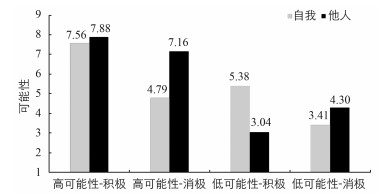全文HTML
-
自我是一个复杂的系统[1]。在时间维度上,自我不仅仅存在于当前,更是从过去发展而来,并延伸至将来。在对自我相关的将来事件的认知中,研究者一致发现了乐观偏差(optimistic bias)现象,即在对将来事件发生概率的认知上,人们通常认为积极的事情更可能发生在自己身上,消极的事情更不可能发生在自己身上或更可能发生在他人身上[2-4];在对将来事件发生的时间距离的认知上,人们通常认为积极的事件发生在自己身上的时间距离更近,而消极事件发生在自己身上的时间距离更远[5]。在不同的被试群体及不同的领域中均发现了乐观偏差现象的稳定存在[6-8]。
有研究者认为乐观偏差主要源于自我增强的动机[9],也有研究者认为乐观偏差是一种自动的、出现于意识之外的情绪过程[10-11]。我们的研究发现,提示将来事件相关的现实因素(现实因素是指与将来事件相关的现实自我因素,与积极将来事件相关的现实自我因素界定为保护因素,与消极将来事件相关的现实自我因素界定为风险因素)能够影响乐观偏差,尤其是提示风险因素能够降低被试的乐观偏差,影响个人的风险知觉,但是这种影响是有限的,并不能完全消除乐观偏差现象[12]。这说明,乐观偏差受到个体认知因素的影响,但同时还受到其他非认知因素的影响,提示现实因素对乐观偏差的影响可能是认知因素与非认知因素综合作用的结果[13]。而人们对自我相关的认知比对他人相关的认知可能涉及更多的情感因素[14-16]。那么,提示将来事件相关的保护因素和风险因素时,个体对将来事件的认知是否存在判断对象的差异?本研究操纵判断视角,考察提示现实因素对将来事件的认知是否存在自我-他人差异,进一步探讨提示现实因素影响乐观偏差的有限性的具体表现。根据解释水平理论[17],自我-他人的认知差异主要源于心理距离,而相似性能够缩短自我和他人的心理距离[18-19]。因而,研究中引入了相似他人和不相似他人,探讨提示现实因素对乐观偏差的影响是否受自我-他人相似性的调节。综上,本研究用可能性和时间距离作为因变量指标,考察提示将来事件相关的保护因素和风险因素对将来事件认知的影响是否存在自我-他人差异,并在此基础上进一步探讨乐观偏差的产生机制。
-
招募44名大学生(自我组和他人组被试各22名,男生15名,其中自我组男生8名,他人组男生7名)参加本研究,年龄范围18-24岁(M=20.98,SD=1.42),被试不了解实验目的,没有参加过相关研究,没有阅读障碍,实验后给予适量报酬。
实验采用2(事件效价:积极、消极)×2(判断对象:自我、他人)×2(事件可能性:高可能性、低可能性)的混合实验设计。为了考察提示信息与事件效价对乐观偏差的影响,设计了“可能性”这一自变量,与现实因素相关的将来事件操作性界定为“高可能性事件”,与其内容相同而效价相反的将来事件界定为“低可能性事件”。事件效价和事件可能性为被试内因素,判断对象为被试间因素。因变量为被试对将来事件发生可能性和时间距离的判断。
-
实验材料与我们先前的研究相同[12-13],包括三个部分:将来事件、与将来事件相关的现实因素(与积极将来事件有关的现实因素为保护因素,与消极将来事件有关的现实因素为风险因素)自评问题(如,总体来说,你对运动的喜欢程度是:1不喜欢,2喜欢),以及提示现实因素与将来事件关系的阅读材料。实验材料共包括46个将来事件和46个提示性阅读材料,其中积极和消极事件各23个,与同一现实因素相关的积极和消极将来事件是同一领域内容相同而效价相反的(如,体型标准和肥胖)。
-
将被试随机分配到自我判断和他人判断条件。首先,呈现总的指导语,详细说明实验流程及反应方式。实验开始时先在屏幕中央呈现时距为750~1 000ms的注视点“+”,随后呈现400~800ms的空屏,在自我判断条件中,给被试呈现一个现实因素评定问题,要求被试根据自己的情况按相应的数字键做出反应,为了操控将来事件的效价,根据被试的不同反应会呈现提示现实因素与积极将来事件或消极将来事件有关的阅读材料。要求被试认真阅读材料,之后采用9点等级判断高可能性事件和低可能性事件将来发生在自己身上的可能性和时间距离,1为完全不可能(或极为接近),9为完全可能(或极为遥远)。至此一个试次结束。整个实验共有23个试次。实验最后要求被试对将来事件的属性进行9点等级评定,包括愉悦度(1非常令人不悦的,9非常令人愉悦的)、重要性(1一点也不重要,9非常重要)和可控性(1完全不可控制,9完全可以控制)。
他人判断用指导语和描述材料来控制。首先给被试呈现一段对人物“X”在某一方面现实特点的描述,如“X是一名大学生。总体来讲,X对运动的喜欢程度是:1不喜欢,2喜欢”,这两个选项中红色的词语为X在这一方面所具有的特点,要求被试认真阅读对X的描述,之后按描述X特点的词语所对应的数字键做出反应,随后要求被试做出自我与“X”在这一方面相似性的评价。评价后呈现阅读材料,要求被试认真阅读材料,之后对高可能性和低可能性的将来事件发生在X身上的可能性和时间距离进行9点等级评定,至此一个试次结束。整个实验共有23个试次。最后被试完成事件属性评定部分。他人判断条件的实验材料和反应方式与自我判断条件相同。两组被试在实验任务完成后均施测生活定向问卷修订版(LOT-R)[20]测量气质性乐观水平,以控制气质性乐观水平对将来事件认知的影响。该量表共有6个题项,采用5级计分,分数越高表明气质性乐观水平越高,具有较高的信效度,是目前广泛使用的测量气质性乐观水平的问卷。本研究中该量表的Cronbach'α系数为0.71。
一. 被试和实验设计
二. 实验材料
三. 实验程序
-
对被试的气质性乐观进行分析,描述统计结果显示,自我判断条件的被试气质性乐观平均分数为19.59±1.35,他人判断条件的被试气质性乐观平均分数为19.41±2.16。独立样本t检验结果表明,两组被试在气质性乐观水平上没有显著差异(p>0.05)。对将来事件的属性评定进行差异检验(见表 1),结果显示,两组被试对积极和消极将来事件的评定在重要性、愉悦度和可控性上均没有显著差异(ps>0.05),可以对研究结果做进一步的统计分析。
-
以事件效价、可能性作为被试内因素,判断对象作为被试间因素进行重复测量方差分析(结果见图 1)。结果显示,效价、判断对象和可能性的主效应均显著(ps<0.01);效价和判断对象交互作用显著,F(1,42)=87.59,p<0.001,η2=0.68,两组被试对积极和消极将来事件的可能性判断均存在显著差异(ps<0.001);可能性和判断对象交互作用显著,F(1,42)=35.95,p<0.001,η2=0.46,两组被试对高可能性和低可能性将来事件的可能性判断均存在显著差异(ps<0.01)。效价、可能性、判断对象三者的交互作用显著,F(1,42)=5.44,p<0.05,η2=0.12;简单效应分析结果显示,对于消极高可能性、消极低可能性、积极低可能性将来事件发生可能性的判断存在显著的自我-他人差异(ps<0.01),对消极高可能性事件和消极低可能性事件发生在自我身上的可能性判断显著低于他人,而积极低可能性事件发生在自我身上的可能性判断显著高于他人,对于积极高可能性的将来事件,自我判断和他人判断之间差异不显著(p>0.05)。
-
重复测量方差分析结果表明(结果见图 2),事件效价、判断对象和事件可能性的主效应显著(ps<0.05);效价和判断对象交互作用显著,F(1,42)=17.90,p<0.001,η2=0.30,两组被试对积极和消极将来事件的判断均存在显著差异(ps<0.01);可能性和判断对象交互作用显著,F(1,42)=18.43,p<0.001,η2=0.31,对高可能性和低可能性将来事件的判断存在显著的自我-他人差异(ps<0.05);效价、可能性和判断对象三者的交互作用显著,F(1,42)=7.59,p<0.01,η2=0.15,简单效应分析结果显示,对消极高可能性、积极低可能性将来事件发生时间距离的判断存在显著的自我-他人差异(ps<0.001),被试倾向于认为消极高可能性事件发生在自我身上的时间距离显著远于他人,而积极低可能性事件发生在自我身上的时间距离显著近于他人,但两组被试对消极低可能性、积极高可能性将来事件发生时间距离的判断没有显著差异(ps>0.05)。
上述结果从可能性和时间距离两个指标上均显示出,在提示将来事件相关的保护因素和风险因素时,被试对将来事件的认知存在自我-他人差异:对自我相关将来事件的认知受事件的效价影响更大,而对他人相关将来事件的认知受提示信息的影响更大。
-
在他人判断条件中,根据被试对自己与他人现实因素相似性的评定将他人划分为相似他人和不相似他人,可能性判断和时间距离判断的描述统计结果见表 2。以事件效价和可能性为被试内因素,判断对象(自我、相似他人、不相似他人)为被试间因素进行重复测量方差分析。可能性判断的结果显示,效价、判断对象和可能性的主效应均显著(ps<0.001);效价和判断对象的交互作用边缘显著,F(2,116)=3.030,p=0.056,η2=0.095;对于积极和消极将来事件的判断,自我与相似他人、不相似他人之间均具有显著差异(ps<0.001),而对相似他人和不相似他人的判断之间没有显著差异(ps>0.05);效价和可能性的交互作用显著,F(1,58)=5.609,p<0.05,η2=0.088;对高可能性和低可能性的积极、消极将来事件的判断均具有显著差异(ps<0.001)。效价、判断对象和可能性三者的交互作用显著,F(2,116)=5.99,p<0.01,η2=0.17,对于高可能性消极和低可能性的积极、消极将来事件,自我判断与相似他人、不相似他人判断之间均有显著差异(ps<0.05),而对相似他人和不相似他人的判断均没有显著差异(ps>0.05)。
时间距离判断的重复测量方差分析结果表明,效价、判断对象和可能性的主效应显著(ps<0.001);效价和判断对象的交互作用显著,F(2,116)=3.33,p<0.05,η2=0.11,对积极将来事件的判断,自我、相似他人和不相似他人三者之间均不具有显著差异(ps>0.05);而对消极将来事件的判断,自我判断与相似他人、不相似他人的判断均具有显著差异(ps<0.001),对相似他人和不相似他人的判断没有显著差异(p>0.05)。可能性和判断对象交互作用显著,F(2,116)=60.07,p<0.001,η2=0.67,对于高可能性和低可能性将来事件,自我判断与对相似他人、不相似他人判断之间均具有显著差异(ps<0.001),而对相似他人和不相似他人的判断没有显著差异(ps>0.05),其他因素的交互效应不显著(ps>0.05)。
这一结果说明,提示现实因素对将来事件认知的影响存在自我-他人差异,而且这种差异不受人际相似性的影响。
-
对可能性判断和时间距离判断结果进行Person相关分析,结果表明,在自我判断中,积极高可能性事件(r=-0.725,p<0.01)、消极低可能性事件(r=-0.573,p<0.01)和积极低可能性事件(r=-0.823,p<0.01)的可能性判断和时间距离判断均具有显著负相关,消极高可能性事件的可能性和时间距离判断相关不显著(r=-0.113,p>0.05)。这说明,判断自我相关的将来事件时,无论事件的可能性水平高低,个体都倾向于认为积极事件发生的可能性较大且发生的时间距离也较近,消极事件发生的可能性较小且时间距离较远。在他人判断条件中,积极低可能性事件(r=-0.673,p<0.01)、消极低可能性事件(r=-0.556,p<0.01)、消极高可能性事件(r=-0.653,p<0.01)和积极高可能性事件(r=-0.48,p<0.05)的可能性判断和时间距离判断均具有显著负相关,即为他人判断时,无论是积极还是消极的将来事件,个体都倾向于认为高可能性事件发生的可能性较高且时间距离较近,低可能性事件发生的可能性较低且时间距离较远。这也说明,对自我相关将来事件的认知主要受事件效价的影响,受提示现实因素的影响较小,而对他人相关将来事件的认知主要受提示现实因素的影响,受事件效价的影响较小。
一. 可能性判断
二. 时间距离判断
三. 自我判断与相似他人、不相似他人判断的分析
四. 可能性与时间距离判断的相关分析
-
本研究通过操纵判断对象,考察提示与将来事件相关的保护因素和风险因素对将来事件认知的影响是否存在自我-他人差异,进一步探讨提示现实因素影响乐观偏差的有限性。研究结果显示,在提示现实因素的基础上,为他人判断时,无论是积极还是消极的将来事件,被试认为其发生的可能性较大而时间距离较近;但是,为自己判断时,无论是否提示保护因素或风险因素,被试都倾向于认为积极将来事件发生的可能性较高且时间距离较近,而消极将来事件发生的可能性较低且时间距离较远。这一结果表明,自己判断比为他人判断在更大程度上受将来事件效价的影响,而为他人判断比为自己判断更大程度上受提示信息的影响。有研究也发现,在积极事件上,小概率事件的乐观偏差显著高于大概率事件,而在消极事件上,大概率事件的乐观偏差显著大于小概率事件[21]。这可能是因为,提示保护因素时,无论为自己判断还是为他人判断,都是为积极将来事件的出现提供了有利的信息,这与乐观偏差的倾向是一致的[2-5]。人们通常对自己的未来具有乐观的态度[9, 22-23],而风险因素对这种乐观态度而言是一种威胁性信息。有研究指出,当认知过程涉及的脑区激活时乐观偏差会降低,而当认知资源受到限制时偏差会增加[24-25]。也有研究发现,人们在看待自我和自我决策中情绪起着更主要的作用,而在看待他人和为他人决策时认知因素起着更重要的作用[15-16]。因而在为他人判断时提示信息对将来事件认知产生了更大的影响,而对自己相关将来事件的判断受事件效价的影响更大。Sharot等人[4]采用fMRI技术,给被试呈现积极或消极事件发生在相同的社会文化背景中相似他人身上的平均概率,他们发现,即使给被试呈现事件发生的实际概率之后,被试仍然会低估消极事件发生在自己身上的概率;这种乐观偏差在“现实”面前的维持与前额皮质降低对将来消极信息的神经编码有关。本研究结果可以看出提示现实因素能够影响对将来事件的认知,但是通过与为他人判断的结果进行比较可以看出,当判断对象是自我时,认知因素的影响会被削弱。这与Sharot等人[4]的研究结果是一致的:个体会抵制对自我相关将来事件的威胁性信息。在对将来事件的认知中,个体可能更关注将来事件是否符合自己的期望。
本研究结果还表明,提示现实因素影响将来事件认知的自我-他人差异不受他人相似性的影响,即便有着相似的现实因素,被试对自我和他人相关将来事件的可能性和时间距离判断仍然存在显著差异。有研究发现,与不相似对象比较时的乐观偏差大于与相似对象的比较[26]。本研究与以往的一些研究结果不一致,原因可能在于,虽然人际相似性是影响人际距离的重要因素,相似性能缩短对方和自己的心理距离[18-19],但是,个体在自我判断时能够通过内省直接思考自己的其他特点,而无论他人与自我在某方面的特点是否相似都不能够“设身处地”地思考他人的其他信息。即使他人与自我在某一方面相似,人际间的心理距离也难以降低或消除。因而,被试对他人的认知较为狭窄,更多基于提示信息进行判断,而对自我的认知则较为宽泛。
综合来看,乐观偏差是一种非常稳定的、普遍的现象。提示将来事件相关的现实因素能够影响乐观偏差,但是从本研究可以看出,相对于他人而言,提示现实因素对自我相关将来事件的认知影响较小,对自我相关将来事件的认知主要受事件效价的影响。研究者从认知、情绪和动机等多方面来解释乐观偏差现象[2, 11, 27],有研究者认为,影响人们对将来事件认识的并不是将来事件效价本身,而是与之相联系的情绪[10]。通过本研究结果也可以看出,乐观偏差是认知因素与非认知因素(情绪、动机)综合作用的结果,非认知因素会削弱认知因素对乐观偏差产生的威胁性作用。但是在提示现实因素时,事件效价对自我相关将来事件认知的影响是源于诱发了情绪还是动机因素,或者是二者兼而有之,这些因素在不同的条件下如何起作用和相互作用,在未来的研究中仍需深入探究。




 下载:
下载:
